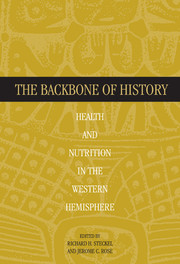Book contents
- Frontmatter
- Contents
- Preface
- List of Contributors
- PART I
- PART II METHODOLOGY
- PART III EURO-AMERICANS AND AFRICAN-AMERICANS IN NORTH AMERICA
- Introduction
- 5 The Health of the Middle Class: The St. Thomas' Anglican Church Cemetery Project
- 6 The Poor in the Mid-Nineteenth-Century Northeastern United States: Evidence from the Monroe County Almshouse, Rochester, New York
- 7 The Effects of Nineteenth-Century Military Service on Health
- 8 The Health of Slaves and Free Blacks in the East
- 9 The Quality of African-American Life in the Old Southwest near the Turn of the Twentieth Century
- PART IV NATIVE AMERICANS IN CENTRAL AMERICA
- PART V NATIVE AMERICANS AND EURO-AMERICANS IN SOUTH AMERICA
- PART VI NATIVE AMERICANS IN NORTH AMERICA
- PART VII
- PART VIII
- PART IX EPILOGUE
- Index
9 - The Quality of African-American Life in the Old Southwest near the Turn of the Twentieth Century
Published online by Cambridge University Press: 01 March 2010
- Frontmatter
- Contents
- Preface
- List of Contributors
- PART I
- PART II METHODOLOGY
- PART III EURO-AMERICANS AND AFRICAN-AMERICANS IN NORTH AMERICA
- Introduction
- 5 The Health of the Middle Class: The St. Thomas' Anglican Church Cemetery Project
- 6 The Poor in the Mid-Nineteenth-Century Northeastern United States: Evidence from the Monroe County Almshouse, Rochester, New York
- 7 The Effects of Nineteenth-Century Military Service on Health
- 8 The Health of Slaves and Free Blacks in the East
- 9 The Quality of African-American Life in the Old Southwest near the Turn of the Twentieth Century
- PART IV NATIVE AMERICANS IN CENTRAL AMERICA
- PART V NATIVE AMERICANS AND EURO-AMERICANS IN SOUTH AMERICA
- PART VI NATIVE AMERICANS IN NORTH AMERICA
- PART VII
- PART VIII
- PART IX EPILOGUE
- Index
Summary
ABSTRACT
This chapter examines the quality of life of African–Americans in the historic West between the Mississippi River and the Rocky Mountains in the late nineteenth and early twentieth centuries. The primary data come from two sites: Cedar Grove Cemetery in rural southwest Arkansas, and Freedman's Cemetery, an urban graveyard located in downtown Dallas, Texas. We compare these skeletal series to archival and other demographic data sets and to a smaller composite skeletal series derived from sites in Illinois and the Great Plains. Issues examined include demography, childhood health and nutrition, growth and development, diet, infection, degenerative joint disease, and trauma. Since Freedman's Cemetery has a relatively precise chronology, the changing health of the African–American community in Dallas is emphasized. Key measures of health declined in urban Dallas during much of the late nineteenth century before improving at the turn of the century, a pattern that likely resulted from improvements in public health infrastructure.
INTRODUCTION
Certainly for many inhabitants of Europe, emigration to the United States seemed a dream given form the American western frontier was a vast land of opportunity containing a wealth of exploitable resources. The essential story was the same from the founding of the American colonies, to the Virginians moving into the Appalachians, and finally on to the land rushes of the western prairies the frontier was where fortunes were to be made and, on a simpler level, where farmland could be obtained with little or no capital.
- Type
- Chapter
- Information
- The Backbone of HistoryHealth and Nutrition in the Western Hemisphere, pp. 226 - 278Publisher: Cambridge University PressPrint publication year: 2002
- 26
- Cited by



